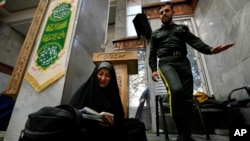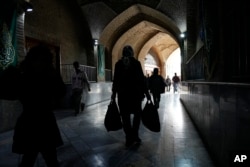Iran's hard-liners were leading in an initial vote count Saturday in the capital, Tehran, following a record-low turnout in a parliamentary election. Officials have not yet released turnout figures, but the state-run IRNA news agency said it was 41%, based on unofficial reports.
After the closure of the polls, videos and reports suggest that many people used their national ID numbers to vote. Until this election, birth certificates had been required as voter identification. Without that requirement, voters used their national ID numbers, resulting in a declared participation rate of 25 million people, according to the newspaper Hamshahri, a staunch supporter of Iranian President Ebrahim Raisi's government.
About 25 million voters would equal a turnout of about 41%, a historic low.
Another report was more detailed. It said 86% of voters in Friday's elections cast their ballots using their national ID cards, 11% with birth certificates, 3% with driver's licenses, and less than 1% with passports and military service completion cards.
According to images released by the official media of the Islamic Republic, the processes of identity verification and ballot paper issuance have been conducted manually. Without a nationwide electronic voting registration system, it remains unclear how authorities can ensure that individuals with various identity documents cannot cast multiple votes across different branches and constituencies.
The statistics, viewed as misleading by social media users because of the election day's atmosphere, suggest that the Islamic Republic is engaged in alleged "statistical manipulation," registering citizens' national ID numbers in the system.
In the final hours of voting, numerous videos circulated on social media depicting various Iranians suggested that some citizens' national ID numbers had been recorded in the system, showing them as having voted before they actually cast their ballots. As of the time of compiling this report, official authorities have yet to provide an official response to these electoral suspicions.
The subdued voter turnout for Iran's elections was notable, as evidenced by the newspaper Ham-Mihan, which initially featured the headline "Silent Majority" on its front page. However, reports indicate that Iranian security forces compelled the newspaper to change the headline of its Saturday edition to "Presence and Absence."
The circulated videos also underscore Iranians' grievances regarding census manipulation, with some users reporting that upon visiting polling stations, they found themselves registered as having voted in the system hours before.
The Hal Vash news site reported that Friday morning, residents of Sital village in the Sarbuk District of Qasr-e Qand County prevented poll workers from setting up and deploying ballot boxes in their community.
Hal Vash reported that to prevent a zero-vote record in the Sital village, the governor of Qasr-e Qand ordered the registration of votes in the names of the villagers using their national identification numbers. Subsequently, ballot papers were deposited into the ballot box.
Despite the low turnout and considering Supreme Leader Ali Khamenei's past criticism of 40% turnout in elections in certain countries as "shameful," government-affiliated media declared voter participation in the March 1 elections to be more than 40% minutes after the voting deadline had passed.
Videos submitted by VOA's audience and images disseminated by other Persian-language TV services outside the country and on social media contradict these assertions.
On Friday, Abram Paley, deputy special envoy for Iran in the State Department, shared his views on the elections in the Islamic Republic on social media platform X, formerly Twitter, stating, "The Iranian regime is attempting to showcase these elections as a display of democracy, yet it has already disqualified thousands of candidates. The Iranian people are fully aware that these elections, regardless of their results, do not truly represent them, and we stand with them in this belief."
He reiterated the United States' commitment to stand alongside the Iranian people, stating, "The United States will continue to shine a light on regime officials involved in such human rights abuses, who deny Iranians their basic freedoms. And we will continue to stand with Iranians in their fight for a free and democratic future."










